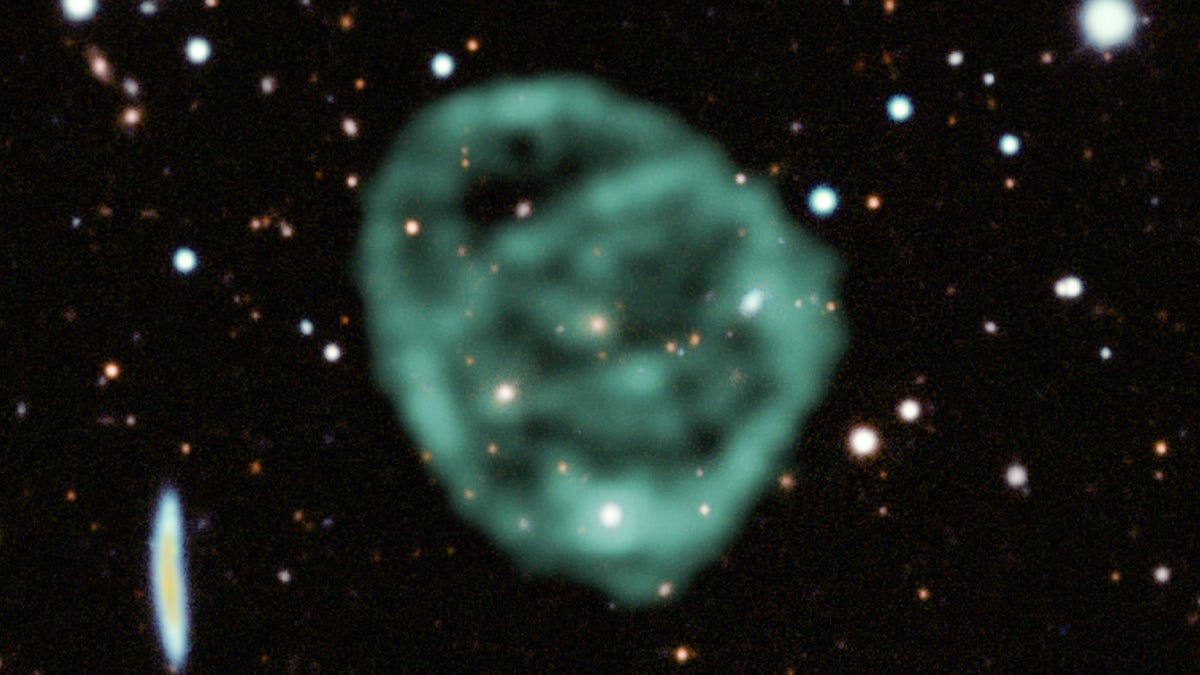Mysterious, Ghostly Radio Circles From Deep Space Probed With Best Images Yet
The faint radio rings pulled into focus, thanks to new images from a South African telescope.

The space Lord of the Rings: The green circle picture here is known as an "ORC," or odd radio circle.
What's about 16 times wider than the Milky Way, looks like a smoky ring and hides out in deep space? Well, astronomers aren't really sure just yet. But with new images, obtained by a South African radio telescope, they are getting closer to understanding a rare and unusual feature of the cosmos.
A little backstory, first.
In 2019, astronomer Anna Kapinska was trawling through data from the CSIRO's Australian Square Kilometre Array Pathfinder, searching for unusual objects the radio telescope may have stumbled upon. She started pulling together a list of "WTF?" features, and included in her inventory of cosmic oddities was a new, unusual object: a faint, ghostly circle about a billion light-years from Earth. A few days later, another astronomer, Emil Lenc, went looking through the same data -- and found a second circle. The researchers dubbed these objects "odd radio circles," or ORCs.
Lenc flagged his find with Ray Norris, an astrophysicist with Australia's chief science body, CSIRO, and Western Sydney University, pulling up the image of the ORC on his computer screen. It looked kind of like the remnant of a supernova, the structure left behind once a star explodes, but the data didn't fit.
"Fairly quickly we realized this is really something quite different," Norris says. "It's something quite new."
What makes them interesting is the fact they are only visible to radio telescopes. The circles don't appear in X-ray telescopes, like NASA's Chandra, or infrared wavelengths, like those used by James Webb.
Since then, the researchers have been able to find and describe five different ORCs, all from similar regions of space. But its ORC1, first spotted by Lenc, that is the star subject of a new paper, set to be published in the journal Monthly Notices of the Royal Astronomical Society.
The latest study used MeerKAT, operated by the South African Radio Astronomy Observatory, to examine the physics of the unusual ring. The telescope array is composed of 64 dish antennas that listen for radio signals from deep space and, importantly, it can focus in on ORC1 with much greater detail than ASKAP could. It also allows the researchers to determine polarization, which is essential to understand the phenomena's magnetic fields.
On the left is the original image of ORC1, taken by CSIRO's ASKAP. The much higher resolution image on the right comes from SARAO's MeerKAT.
Using MeerKAT, the team have been able to take the highest resolution images of an ORC yet. "They show us the structure in ORC1 that we didn't know was there before," says Norris. In the image above, you can see the stark difference in quality between the two observations. ASKAP and MeerKAT are working a bit like a Holmes and Watson duo, each contributing their own strengths to solving the cosmic mystery of ORCs.
Have the telescopes solved the case? Do the new images reveal the true nature of an ORC? Unfortunately, no. However, they do help bolster evidence for a few leading candidates.
Norris has a personal favorite. He thinks the ORCs are shockwaves produced after the merger of supermassive black holes in a extremely distant galaxy. The radio circle is an expanding bubble of gas that interacts and excites electrons at its border to create the faint signals spotted by our telescopes on Earth. If this monolithic collision sparked the ORC, then we'd expect to see supermassive black holes at their center. "And we do," says Norris. In fact, of the five ORCs described so far, three have black holes at their center.
To get a better read on his theory, Norris says he will propose to use the Extremely Large Telescope, in Chile, to look at ORC1 in optical wavelengths, rather than radio. This, Norris says, "might tell us what's going on in those galaxies."
Another theory is that ORCs are created by a "starburst termination shock." Some time ago, the central galaxy in ORC1 experienced a period of huge star forming and exploding activity. "With all these stars exploding, you get a big overpressure of gas in the galaxy, and it blasts out," says Norris. This, he says, could cause a radio circle similar to those observed by ASKAP and MeerKAT.
The dishes of the MeerKAT at sunrise.
But so far, neither scenario perfectly explains an ORC -- and they could be something else entirely. And there's another potential wrinkle in the tale. Of the five ORCs discovered so far, ORC2 and ORC3 seem a little different. They're close together and likely related. Norris and others are looking at the ORC pair as distinct from the pair of single ORCs, like ORC1.
You can only go so far with limited clues, as any good cosmic detective knows. Norris says that because ORCs are so rare and so faint, there's a lot of theorizing and guessing as to what they might be. "What you're trying to do is trying to get the evidence which will turn those guesses into reasoned arguments," he notes.
More ORC observations will move the needle, but for now, the mysterious radio circles remain an oddity.

